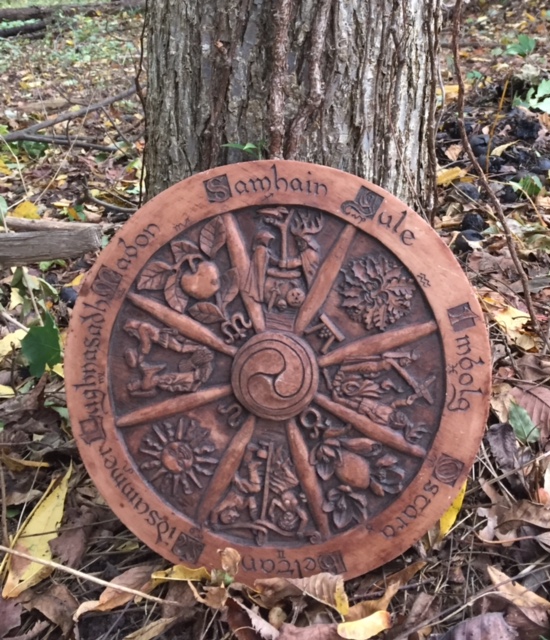The Seasonal Psychologist is a year-long series by Pagan Psychologist Betz King. Each piece corresponds to one of the 8 Pagan Sabbats, or holidays, while exploring ways to use the symbolism of the season for personal growth and in clinical practice.
I conceptualize both my personal development, and that of my clients, within the framework of our local 4-season landscape. Mostly this means a framework of trees, crops native to Michigan, and lots of plants, crops and flowers. The Pagan path is a seasonal one, hosting 8 holidays called Sabbats. They parallel the movement of the sun across a year. Each holiday expresses a facet of the relationship between Light, Dark and life. I use them as lenses of reflection, opportunities to contemplate the cycle of birth, growth, harvest and death that impacts all living beings.
As a Pagan psychologist, many of my clients have some form of an earth based belief system. This allows us to revisit treatment goals seasonally. The view from my office window is lush with trees. A simply glance outside provides the framework for our review; whatever the trees are doing becomes an invitation to consider the same within ourselves.

Holidays at the end of October and the beginning of November often thematically involve death, darkness, atonement, endings and reflection. All Saint’s Day, All Soul’s Day, All Hallow’s Eve and Dios de los Muertos have all lent influence to the most secular and widely celebrated Halloween.
My holiday, Samhain (pronounced SOW-in) honors the end of the harvest season, the darkest, coldest time of the year and the influences and gifts of our ancestors. It is believed that the ‘veil between the worlds’ is thinnest at this time, which allows communication with ancestors who have crossed into the Summerland (a sort of Pagan heaven). Our Halloween ghosts and goblins are very watered down expressions of this ancestor homage. Given that the next Pagan Sabbat, the Winter Solstice, is when the days grow longer and the light returns, some Pagans (including myself) consider Samhain to be the Spiritual New Year.
Psychologically, this is a time to contemplate one’s accomplishments from a big picture, year long perspective, as one might contemplate the health and bounty of the crops after the harvest has come in. It is a time to set new goals for the coming year, and to give thanks to the ancestors for their many gifts and blessings. As a chill comes to the air and the days grow shorter, this is also a time of surrender and endings, as we in Michigan pull out our winter clothes and begin to spend more time indoors. Some years the trees are completely naked, having dropped all of their leaves with grace and ease. Other years they are full still. I remind myself and my clients that we get to choose how we let go of things that no longer serve us. We can surrender and accept, or we can gnash our teeth and fret. Leaves falling outside the therapy room window are lovely teachers. They remind us that even in seeming death, there are the seeds of new life.
This week, my clients and I will talk about their entire past year of treatment goals. We will celebrate goals met, assess those still pending, and if appropriate, explore and honor the influence and gifts of the ancestral family tree. I will remind them that the next 6 weeks are the darkest of the year, and we will discuss strategies to cope. We will also contemplate the darkness of our unexpressed shadow parts, our own inner demons and gremlins that have so much to teach us. Lastly, as part of the Spiritual New Year, we will make amends to those we have harmed, and set goals for spiritual growth and actualization for the year ahead.
As the daylight grows shorter and Halloween offers it’s pageantry of costumes, I invite you consider the costumes that you wear. Do they still fit or have you outgrown them? Would you like to try another? Is there a Halloween costume that you are drawn to, and if so, what might that mean? Could it be a message from your hidden and powerful shadow side?
Carl Jung (1945) devoted much of his work to the exploration and excavation of the shadow, and his words are particularly potent at this time of the year:
“Filling the conscious mind with ideal conceptions is a characteristic of Western theosophy, but not the confrontation with the shadow and the world of darkness.
One does not become enlightened by imagining figures of light, but by making the darkness conscious.
The later procedure, however, is disagreeable and therefore not popular.”
How can you use this reflective time to learn more about the relationship between your ideal and shadow parts, in service of illuminating the sweet spot where polarities are integrated into wholeness?

When the ghosts and goblins come to your door, take a moment to consider the ways that you are like those people and animals who are no longer part of your daily life, but remain in your heart. How are you keeping their energy alive in the world? Light a candle next to their pictures and be grateful to stand on their shoulders.
By becoming more familiar with both internal and external darkness, and by considering ourselves as an extension of all who have come before and left pieces within us, we meet the year’s end with enough grace and courage to begin another trip around the Sun and the seasons.
To all celebrating, Blessed Samhain and Happy Halloween!
Jung, C. G. (1945). The Philosophical Tree. In CW 13. Alchemical Studies (p. 335). Princeton, NJ: Princeton University Press.
 Betz King, PsyD, LP is an associated faculty member in MSP’s master’s program. About her new blog series, she writes, “The Seasonal Psychologist explores my intersectionality as a Solitary Pagan and psychologist, through an integration of teachings and tools from both psychological and spiritual traditions.” Read more about Dr. King, including her American Priestess / Priest Training Program, here.
Betz King, PsyD, LP is an associated faculty member in MSP’s master’s program. About her new blog series, she writes, “The Seasonal Psychologist explores my intersectionality as a Solitary Pagan and psychologist, through an integration of teachings and tools from both psychological and spiritual traditions.” Read more about Dr. King, including her American Priestess / Priest Training Program, here.